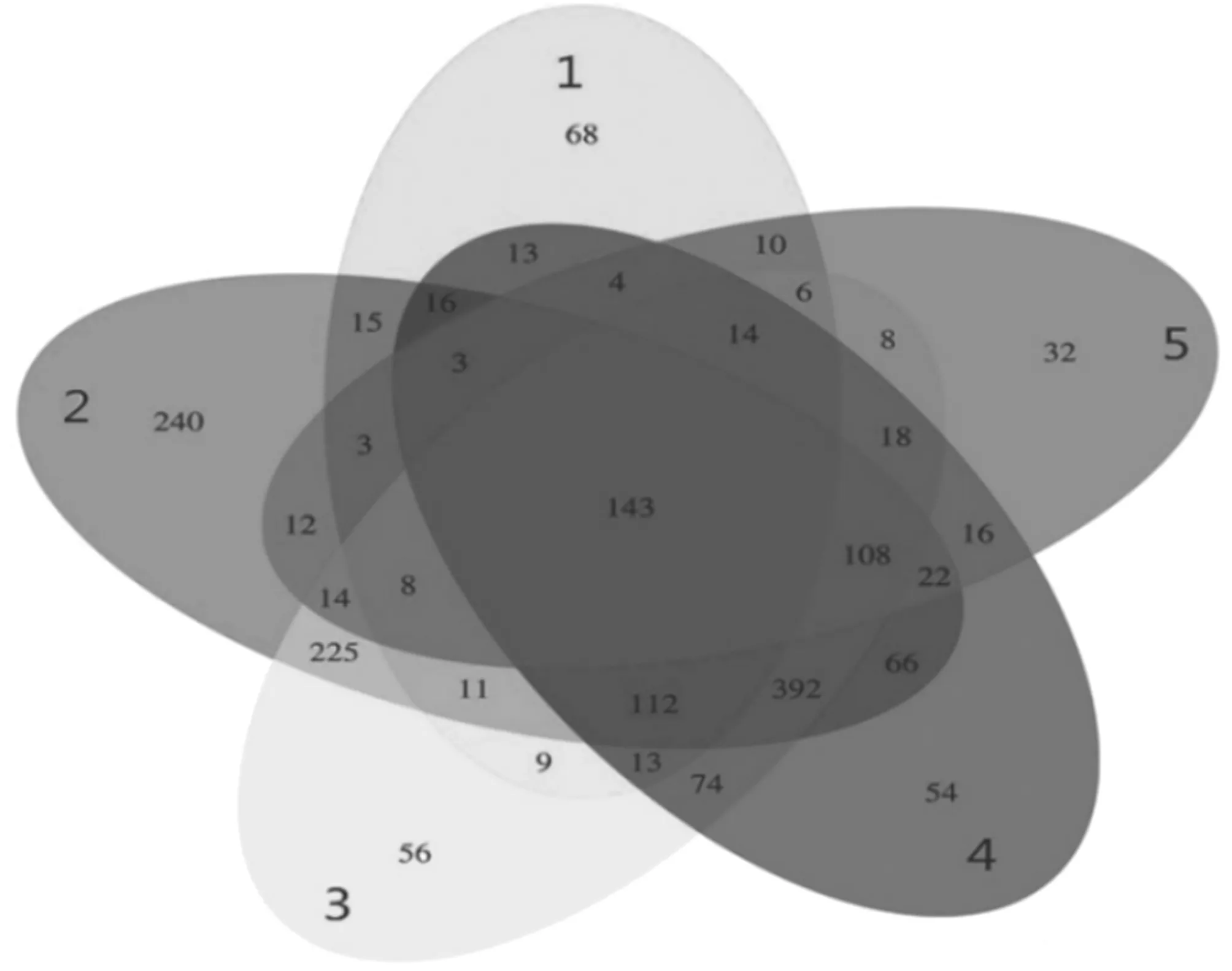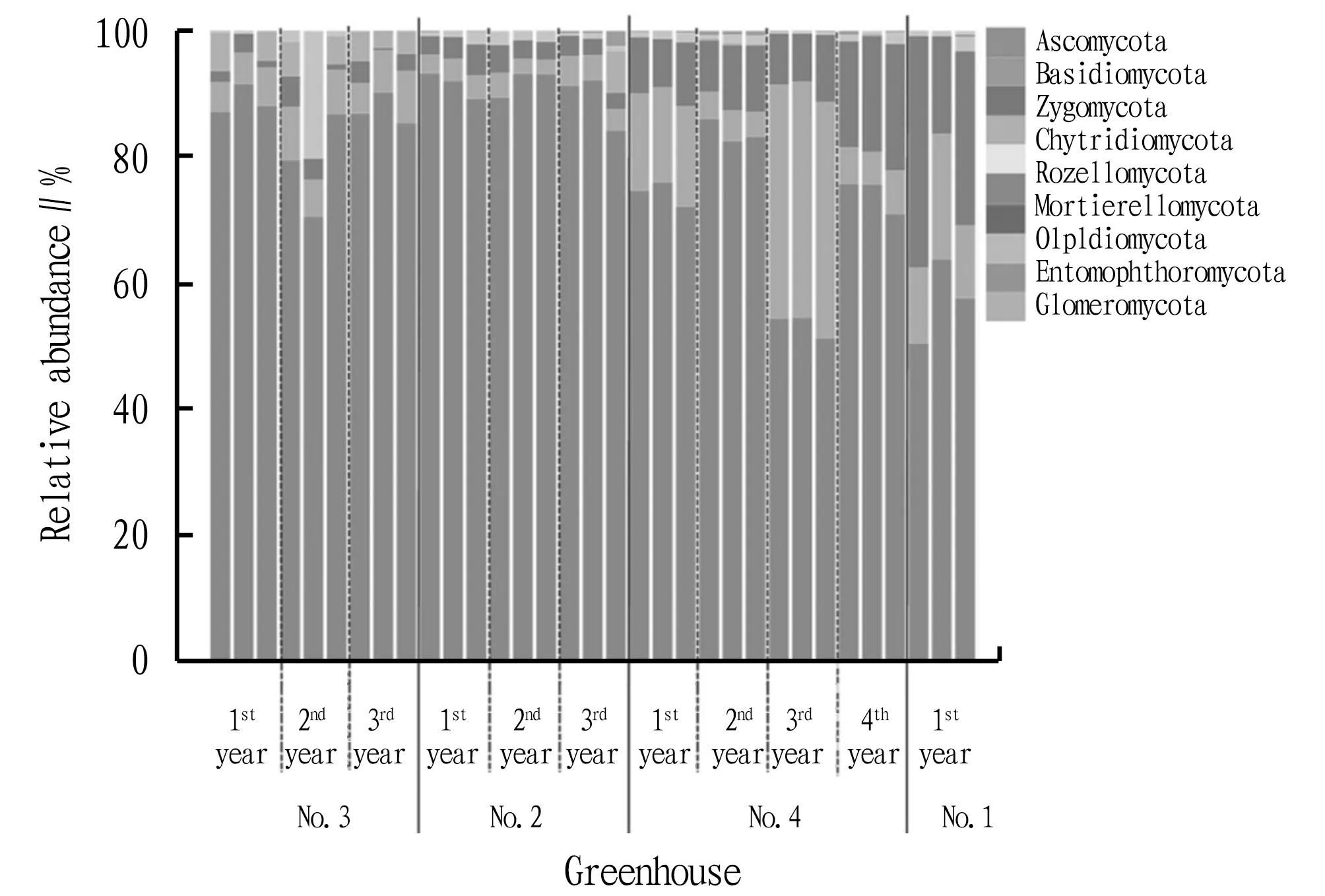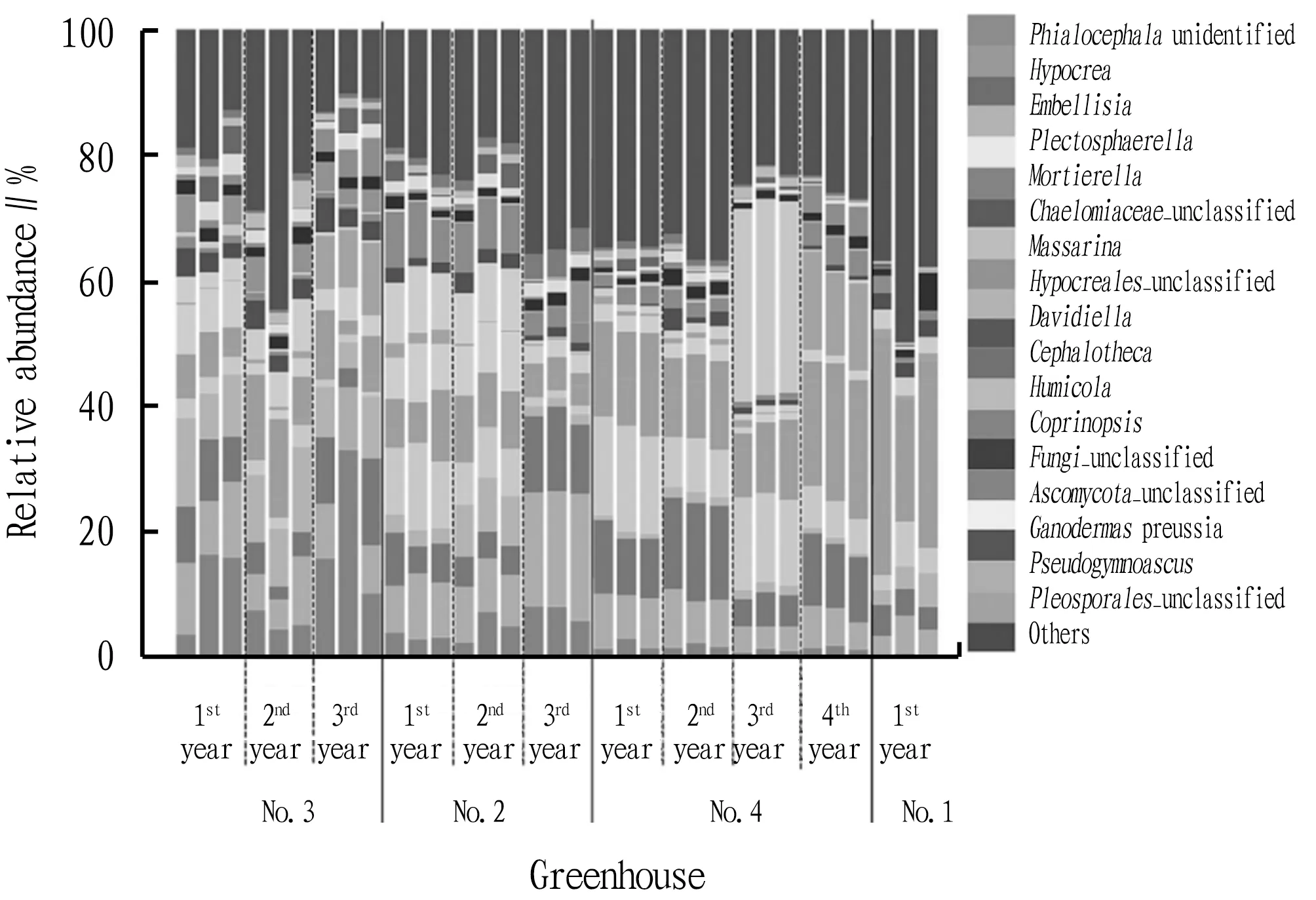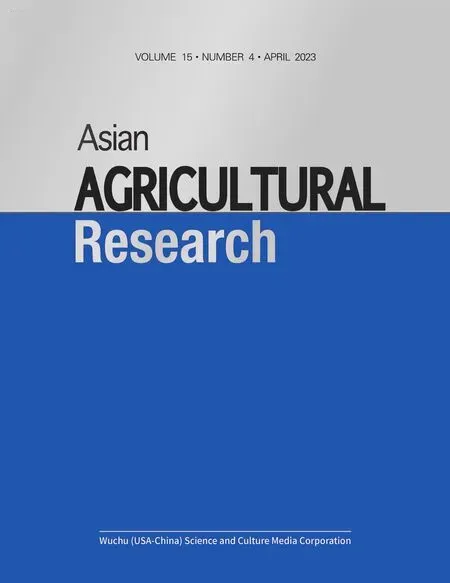Effects of Continuous Cropping and Crop Rotation on Fungal Diversity in Greenhouse Soil
Lei GAO
Institute of Vegetables, Tibet Academy of Agricultural and Animal Husbandry Sciences, Lhasa 850000, China
Abstract [Objectives] To explore the effects of continuous cropping and crop rotation on fungal diversity in greenhouse soil. [Methods] Using the greenhouse soil grown with Ganoderma leucocontextum in different continuous (rotation) cropping years as experimental materials, the change trend of soil fungal diversity in different continuous (rotation) cropping years was studied. Through high-throughput sequencing technology combined with related bioinformatics methods, the richness, diversity index and community structure of the fungal ITS1+ITS2 region in the soil were analyzed. [Results] Continuous cropping or crop rotation could increase the diversity of microbial communities. Ascomycota, Basidiomycota and Zygomycota were dominant fungi. The proportion of Basidiomycota gradually increased with the increase of continuous cropping years, and the abundance decreased after crop rotation. [Conclusions] This study is intended to provide a theoretical basis for the research on continuous cropping and crop rotation obstacles.
Key words Ganoderma leucocontextum, Fungi, Diversity
1 Introduction
Microorganisms in the soil mainly influence the utilization of nutrients through absorption and transformation, while the reason for the low soil nutrient level and the decline of product yield and quality may be the changes in microbial population[1]. A long continuous cropping period of the crop will lead to a simplification of the microbial population structure in the soil, resulting in a sharp decline in soil quality, changes in soil pH, and even a large reduction in product yield or total crop failure. The cause of crop yield reduction is mainly fungi, such asFusariumoxysporum,PhytophthoraandAnthracnoseand other pathogenic fungi. In view of these, we studied the effects of continuous cropping and crop rotation on fungal diversity in soil from the aspects of fungal quantity and species, to provide a theoretical basis for continuous cropping obstacles[2-3].
2 Materials and methods
2.1 Time and placeThe experiment was carried out in the greenhouse of the Tibet Autonomous Region Modern Agricultural Industry Demonstration Park from March to August 2019.
2.2 Experimental materialsThe experiment set up 5 adjacent greenhouses: (i)G.leucocontextumhas not been planted for many years; (ii)G.leucocontextumhas been continuously cropped for 2 years; (iii) continuous cropping ofG.leucocontextumfor two years and then rotation of Morchella; (iv) continuous cropping ofG.leucocontextumfor 3 years and then rotation of garlic seedlings; (v) continuous cropping ofG.leucocontextumfor three years and replacing soil. Kit: E.Z.N.A.®Soil DNA Kit.
2.3 Sampling and storageSoil samples were taken from five greenhouses before and afterG.leucocontextumwas planted and stored at -20 ℃.
2.4 Experimental methods
2.4.1Extraction of soil microbial genomic DNA. Weighed 0.5 g of soil samples and stored at -20 ℃, and extracted the total microbial DNA according to the test procedure of the kit, and stored the DNA samples at -20 ℃ for later use.
2.4.2Experimental procedure. After extracting the total DNA of the sample, the primers synthesized by the fungus ITS1+ITS2 were obtained according to the design, and the primer adapters were combined for PCR amplification. PCR reaction system: 10.0 μL of 10×Buffer containing 15 mmol/L MgCl2, 2.0 μL of 2.5 mmol/L dNTPs, 5.0 μL of each 10 mmol/L primer; 5 U/μL Taq enzyme 1.0 μL, DNA template 4.0 μL, sterilized deionized water 73.0 μL, total volume 100 μL. PCR reaction conditions: 94 ℃ for 5 min; 94 ℃ for 30 s, 55 ℃ for 30 s, 72 ℃ for 30 s, 30 cycles; 72 ℃ for 1 min. Library construction: purified, quantified and normalized the products to form a sequencing library. The built library was first checked for library quality. The qualified library was detected by HiSeq PE250 and sequenced by Lianchuan Biotechnology Company[4].
2.4.3Data processing. The experimental data were statistically analyzed using Excel and SPSS software.
3 Results and analysis
3.1 Cluster analysis of soil fungal OTUs with different continuous cropping yearsThe effective sequences of all samples were clustered, and these sequences were clustered into OTUs according to the sequence similarity of 97%, to obtain the sequence of each cluster and its representative sequence (namely, OTU), for using to count the sequence and abundance of each OTU for downstream analysis[5]. From the Venn diagram in Fig.1, it can be known that the total OTUs of greenhouse No.1 were 448, the total OTUs of greenhouse No.2 were 1 390, the total OTUs of greenhouse No.3 were 1 211, the total OTUs of greenhouse No.4 were 925, and the total OTUs of greenhouse No.5 were 421. There were 143 common OTUs among the five samples, among which the number of OTUs unique to greenhouse No.2 was the largest, reaching 240. (Due to abnormal data during the soil replacement process of greenhouse No.5, no follow-up analysis would be carried out).

Fig.1 Venn diagram for soil samples of each greenhouse
3.2 Analysis of Alpha diversity of soil fungi in different continuous cropping yearsAlpha diversity is also called species diversity within a habitat[6], including Chao1, Observed_species, Goods_coverage, Shannon and Simpson indices. Using the Alpha diversity analysis method to analyze the total number of OTUs and Chao1 index in soil samples, the diversity and value of fungi in continuous cropping soil could be obtained[7]. Table 1 indicates the results of soil fungal Alpha diversity under continuous (rotary) cropping of different years.
From Table 1, it can be seen that during the growth ofG.leucocontextum, the total number of OTUs and Chao1 index of the fungi in the rotation and continuous cropping soils were higher than those in the greenhouse withoutGanodermalucidum. The variety of crop rotation after continuous cropping had a certain effect on the total number of OTUs and Chao1 index of the greenhouse soil fungal community. The analysis of Alpha diversity showed that both continuous cropping and crop rotation could increase the diversity of microbial communities.

Table 1 Results of soil sample diversity index
3.3 Species analysis of soil fungal community phylum composition in different continuous cropping yearsAccording to the species abundance table, we selected the 20 species with the highest abundance to classify, calculate the relative abundance, obtained the relative abundance data, and plotted the sample abundance histogram, which is convenient for more intuitive comparison of sample abundance[8-9]. In Fig.2 and Fig.3, the horizontal axis is the sample name, each sample has 3 replicates, and the vertical axis represents the relative abundance of phyla and genera; different colors correspond to different species. From the phylum-level histogram in Fig.2, it can be seen that the fungi with the highest proportion in each greenhouse soil were Ascomycota, followed by Basidiomycota and Zygomycota. Continuous cropping increased the relative abundance of Basidiomycota, and crop rotation decreased the relative abundance of Basidiomycota, but increased the relative abundance of Zygomycota.

Fig.2 Histogram of relative abundance of each sample at phylum level
From the histogram of genus level in Fig.3, it can be seen that the content of endophytic bacteria (Phialocephala) in greenhouses No.2, 3 and 4 was more, and the content of endophytic bacteria in greenhouse No.1 was less. The content Hypocrea in each greenhouse soil was high. The content of Plectosphaerella was higher in greenhouses No.2 and No.4, and less in greenhouses No.1 and No.3. The content of Massarina was higher in greenhouses No.2 and No.3, less in greenhouse No.4, and not in greenhouse No.1. Ganoderma exists in greenhouses No.2 and No.3, and No.4 except greenhouse No.1.

Fig.3 Histogram of relative abundance of each sample at genus level
4 Conclusions
Through microbial sequencing technology, we obtained the phylum, genus and abundance of fungi in soil samples ofG.leucocontextumin rotation and continuous cropping were obtained. We found that continuous cropping or crop rotation could increase the diversity of microbial communities. Ascomycota, Basidiomycota and Zygomycota were the dominant fungi. The proportion of Basidiomycota gradually increased with the increase of continuous cropping years, and the abundance decreased after crop rotation, but the relative abundance of Zygomycota increased. However, there are still a large number of categorical fungal species that have not been identified, especially the genus-level fungi. Therefore, it is necessary to make further research and identification.
 Asian Agricultural Research2023年4期
Asian Agricultural Research2023年4期
- Asian Agricultural Research的其它文章
- Analysis of Visualization Mapping in the Field of Brand Community Based on CiteSpace III
- Establishment of Molecular Biological Method for Identification of Bacteria by 16S rDNA and gyrB Gene
- Amplification and Bioinformatics Analysis of h-ns Gene of Vibrio alginolyticus
- Cloning and Bioinformatics Analysis of vscB Gene of T3SS Chaperone of Vibrio alginolyticus
- Effects of Addition of Amino Acids or Soybean Phospholipid in Diet on Slaughter Performance and Meat Quality of Pigs
- Changes in Soil Organic Matter, Nitrogen and Phosphorus Contents during Decomposition of Pear Branches
